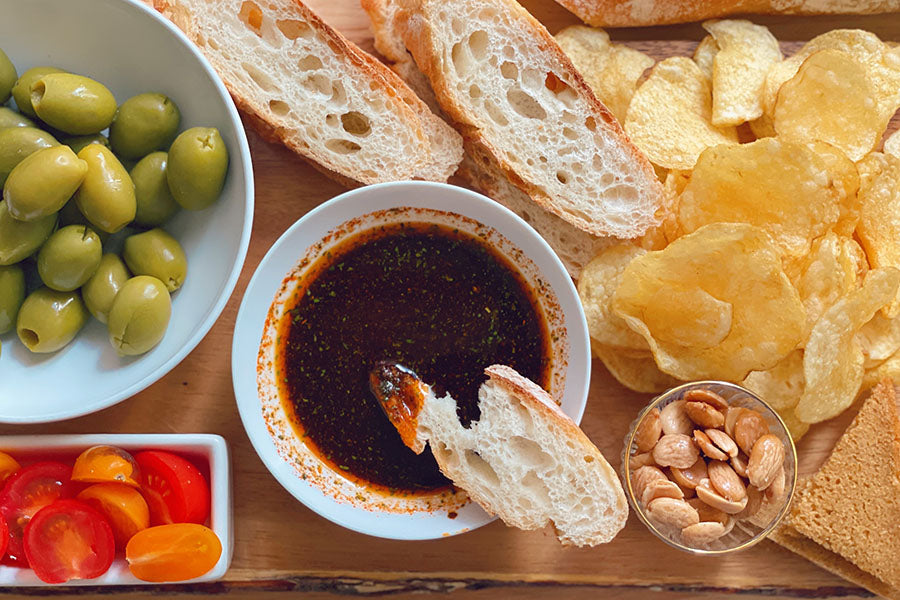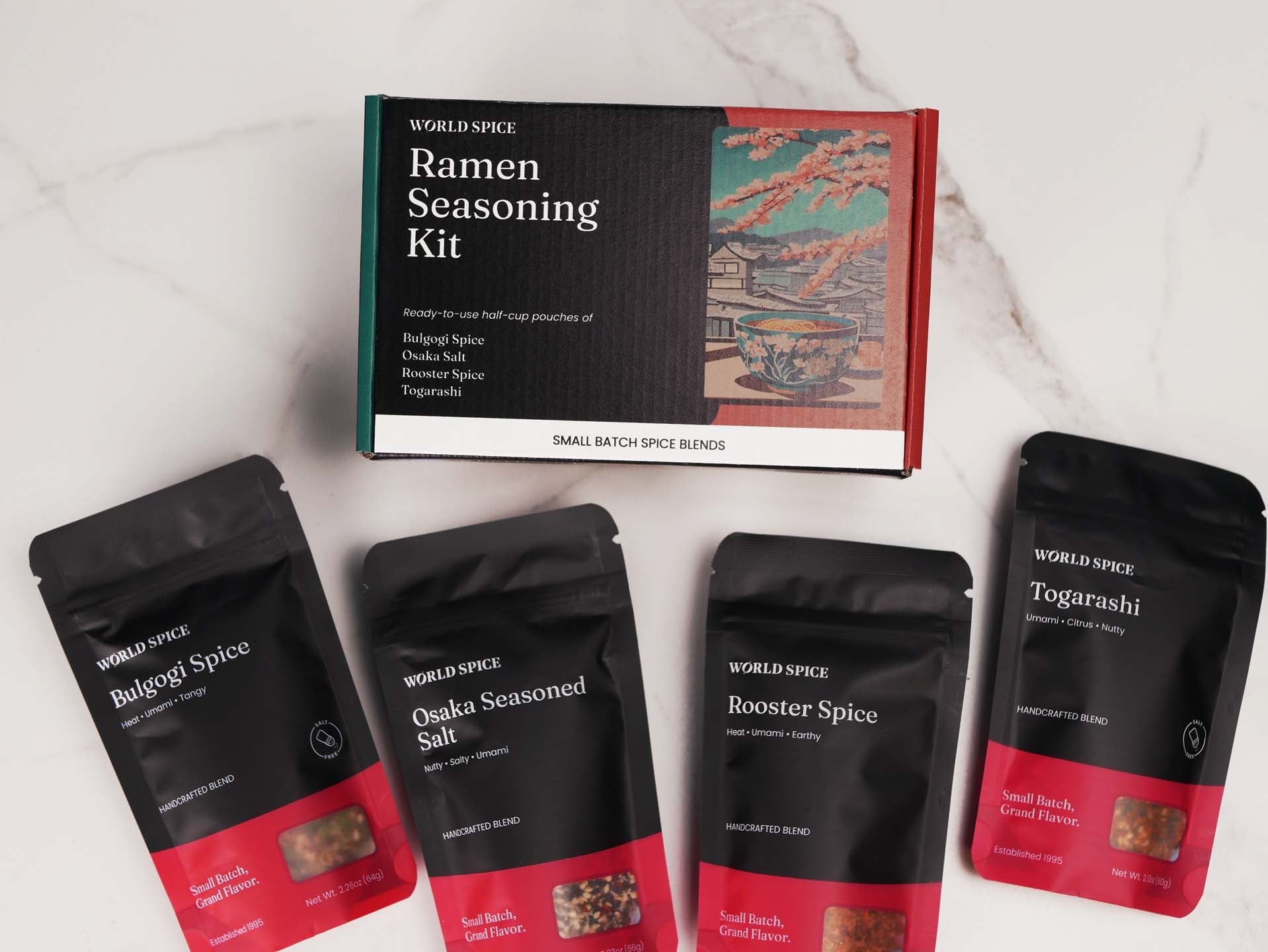Recipes
Gingerbread Caramels
Some spices are just born leaders, with big loud voices and an overwhelming presence. Mace can be one of those show-offs, unless properly tamed. Mace is actually the lacy outer covering of the nutmeg, but its flavor is a bit earthier than nutmeg - think bass vs. soprano. Here we're getting the most out of it's character by combining it with other spices to recreate the scintillating flavor of freshly baked gingerbread, but in a soft, chewy caramel candy, perfect for gift-giving this holiday season.Now there's nothing to fear in caramel making, as long as you follow a few simple rules. Rule #1 is know your altitude. Sugar cooks quicker (which means that water evaporates faster, and that's what control's your ultimate texture) at higher altitudes, so the general rule is to subtract 2 degrees for every 1000 feet above sea level from your final temperature. For example, our basic, sea level recipe calls for a final cooking temperature of 240 F. for a soft caramel. My kitchen is around 3000 ft., so, after a bit of experimenting, I finally altered the target temperature to 238 F. It may take a few tries to find the softness that you prefer - I like my caramels a bit on the softer side. The second rule to follow is to STIR CONTINUOUSLY while cooking the caramel. Dairy products burn really easily at high temperatures, and you don't want that. Thirdly, know your thermometer. Test it by filling a large glass with ice and enough water to separate the cubes. Let it sit for a minute, then insert your thermometer - it should read 32 degrees. If not, make a note of how far off it is, and adjust your cooking accordingly. And remember, the caramel mixture will be extremely hot, so resist the temptation to taste it until it's cooled off. I like to keep a dab on my spatula for tasting purposes, since it will cool off quickly. Follow these few rules, and you'll find yourself on the road to candy making success.Note: To make clean up a breeze, after you pour out the caramel refill the pot with water. Cover and bring to a boil, then set aside for a few minutes. The hot water and steam will help dissolve the cooked sugars.
Learn moreHopi Beef Stew with Cornmeal Dumplings
When the weather starts to cool off, there's nothing quite so comforting as a hot bowl of chunky, homemade stew. This Southwestern style Hopi Beef Stew with Cornmeal Dumplings brings together some of the crops which originated in the Americas - squash, pumpkin, chile peppers and, most importantly, corn.Corn is considered sacred amongst the Pueblo and Navajo people, and plays an important role in their legends, ceremonies and daily lives. Most of us are used to only seeing yellow corn, but it also comes in a variety of colors, including red, blue and multi-colored. Here, we've combined yellow cornmeal along with other traditional ingredients and our own New Mexico Chili Powder, a mild, earthy blend of New Mexico chile, guajillo chile, paprika, cumin, garlic and onion. We've also included our own Alderwood smoked salt and, in the dumplings, some ground sage to bring a dash of Southwestern flavor.Recipe adapted from Marcia Keegan, "Pueblo and Navajo Cookery," Earth Books, 1977
Learn moreMexican Street Corn
Full of flavor and a crowd pleasing party food, Mexican Street Corn has become a seasonal favorite. The rich roasted corn topped with creamy sauce is the perfect base for our Yucatan Rojo BBQ Rub. The spices are subtle and complement the corn with hints of cumin, allspice and true cinnamon. Annatto seeds add a pop of color and earthy base while fresh cilantro and lime finish the dish.
Learn moreCauliflower Tortillas
Sorry corn, I love you, but I don't need you anymore. I have a new BFF - and it's name is cauliflower. Please don't be jealous - you'll always have a place in my kitchen, just not when it comes to making tortillas. Cauliflower, the new low-carb darling, does an amazing job at creating flavorful, flexible tortillas good enough for sandwich wraps, tacos, enchiladas - even lasagna, if seasoned properly. And that's the beauty of this recipe - you can flavor these tortillas any way you like, whether it's for Mexican food, Greek gyros, or, and here's the most amazing thing of all: as a stand-in for Caraway Rye Bread. Oh, how I've missed the unmistakable flavor of a fresh slice of rye bread! Well, I'm here to tell you that it's back on the menu, cauliflower style. All it takes is a spoonful of our Ranch seasoning and a some whole caraway seeds, and the transformation is complete. Welcome back, turkey, corned beef, and pastrami sandwiches!
Learn moreGrain-Free Yucatan Tamales
What could be more enticing than a tender, fragrant home-made tamale? Pillowy soft steamed masa on the outside, secret pockets of glorious filling and sauce on the inside. Home-made food is all about the love, and this recipe has that and more, because it's also all about the carbs, or, more specifically, the lack of them. You see, these babies bypass the use of corn for the masa, opting instead to incorporate our old friend, the cauliflower. Yes, it can be done!This new take on a traditional food is actually easier to make, since we'll be using parchment paper instead of corn husks, and baking in the oven instead of steaming on the stove. This technique allows the excess moisture in the cauliflower masa to evaporate out, and the eggs provide the necessary lift to make the dough puff up. The Yucatan Rojo BBQ Rub adds a subtle, spicy note that helps tame the flavor of the cauliflower, and the nutritional yeast adds a touch of umami. We've used any number of fillings for these tamales, from a quick store bought pork chili verde to your favorite pulled pork recipe. So gather up a few extra hands, and get ready for a tamale party!
Learn moreSheet Pan Chicken Pot Pie
Need something new to bring to your next potluck, or just an easy meal to feed a crowd? Try thinking beyond the typical foods that come in a bowl: soup, chili, salad, or fruit salad. How about bringing it in style with a fragrant, golden, pastry-topped chicken pot pie, big enough to serve 12? I'm talking about the quintessential comfort food served up in a sheet pan - the 12" x 17" rimmed workhorse of every serious baker's kitchen. Our version takes the classic pie one step further by using our Provencal Seasoned Salt as the secret ingredient. The delicate, summery notes of this French-inspired blend will bloom throughout the saucy filling, bringing hints of fennel, garlic, chervil, and tarragon that perfectly compliment the chicken and vegetables. You can choose to go the quick route, using rotisserie chicken, store-bought pie crust, and frozen vegetables, or channel your inner homemaker with oven baked (or in my case, microwaved) chicken thighs and homemade pie crust. If you're making your own pie dough, using part shortening/part butter makes for a more flexible crust, which is easier to work with in a large sheet like we're doing here. We like the classic combination of carrots, celery, onion and peas, but feel free to throw in whatever vegetables catch your eye. One important note: place a large baking sheet or piece of foil on the rack below the sheet pan to catch any drips. You'll be glad you did!
Learn morePumpkin Seed Dip with Yucatan Rojo Spiced Oil
This traditional Yucatan dip, known as Sikil Pak, is made from a base of ground pumpkin seeds, or pepitas. On it's own, it has a fresh, creamy, nutty taste, lighter in flavor but similar in texture to a traditional hummus dip. But when drizzled with our Yucatan Rojo spiced oil, something magical happens. Each bite offers a contrast in flavors, with the earthy Rojo-spiced oil adding a vivid contrast to the mellowness of the pepitas, elevating this Mexican party dish to a whole new level. This dip whips up in a jiffy, especially if you use pre-salted and roasted pepitas, though you can opt to toast your own. Serve it with crackers or tortilla chips, along with fresh crudites such as sliced jicama, carrots, snap peas and green pepper strips for an inventive alternative at your next barbeque or potluck. The spiced oil also makes a great topping when drizzled on fish tacos, scrambled eggs, burgers, pizza, or just about anything else you can think of.
Learn moreNigella Wheat - Free Thins
These delightful grain-free crackers are sure to become a favored new addition to your baking repertoire. Slightly sweet from the almond flour, yet savory enough to use with a dip, these wheat-free, grain-free crackers are easy to make and keep exceptionally well for whenever that 'crunchy' craving hits. The Nigella Seed add an extra dimension of toasty, oniony flavor and a toothy bite that creates an exceptionally satisfying mouth-feel. Nutritional yeast is an inactive yeast that lends a cheesy, nutty, savory flavor as well as a bounty of nutrients, including B vitamins, trace minerals and all 9 essential amino acids. The result? All of the taste, but none of the guilt in a snappy little snack cracker.
Learn moreGrilled Polenta and Vegetables Provencal
Summer = grill = good times. Especially when it comes to fresh vegetables. Throwing your vegetables onto a hot grill gives them that "je ne sais quoi" you can't get any other way. And when you add a touch of our Provencal Seasoned Salt, well, it's enough to make the most reluctant veggie eater sit up and take notice. The bright, lively flavors of this seasoning salt can turn the most mundane zucchini and eggplant into a French-inspired masterpiece. Now, those nice crispy veggies need somewhere to bed down, so why not throw a firm piece of creamy, luscious polenta, also spiked with Provencal Seasoned Salt, onto the grill with them? The Provencal Seasoned Salt, featuring a blend of fennel, garlic, chervil, tarragon and other spices carries beautifully throughout the dish. There you have it, a perfectly matched set. This easy method for cooking polenta comes to us from the folks at America's Test Kitchen. Adding a pinch of baking soda to the boiling water serves to soften the outside of the polenta grains, allowing them to quickly break down and release their starch, eliminating the need to stand over a hot stove, stirring constantly for 25 minutes. What's not to like about that?
Learn more














